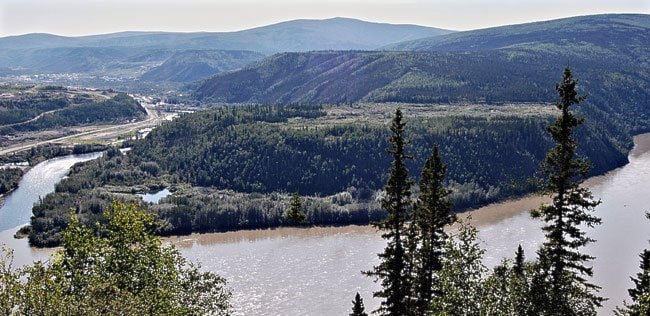Ronald Johnson remembers growing up in a cabin across the Klondike River from Dawson City.
Back then, the neighbourhood was known as Lousetown.
Johnson didn’t realize it was also Tr’ochek - a site traditionally used by the Tr’ondek Hwech’in.
As a child, the longtime Dawson resident played on a bluff overlooking the river, where he could watch the steamers arrive from Whitehorse. His favourite playgrounds were gold rush relics - abandoned trains, a decaying sawmill - and he remembers his family caught fish in the Klondike River near the bluff, grew vegetables in their garden and gathered berries from the terrace above the confluence of the Klondike and the Yukon rivers.
In the summers, the family would go up the Klondike River to various camps and lived off the land in the traditional manner.
There were times around
freeze-up and breakup when Johnson had to walk up the Klondike Valley to the Ogilvie Bridge, then back down to the other side to town, he said. If he was lucky, he might be picked up by the school bus coming in from Bear Creek.
On Saturday, all these memories came flooding back when Johnson gave the opening prayer at a ceremony to unveil a commemorative plaque marking the site’s national significance.
“It was one of the principle Tr’ondek Hwech’in Han camps, and was an integral part of the annual round ... from mid-summer to late fall, the Han harvested and dried salmon, collected berries, hunted moose and caribou, and prepared foods for winter storage,” according to the Historic Sites and Monuments Board of Canada.
Tr’ochek is important because it is representative of the Han cultural landscape of the middle Yukon River Valley: “The site speaks to the Han peoples’ use and understanding of their traditional territories and ... the value they place on this landscape is reflected in their oral histories, language, place names and continued use of the site,” says the board.
But for Johnson, it’s also home.
His family came to Tr’ochek during the 1930s and lived there until the early 1960s, when they relocated to the other side of the river, in Dawson.
The site is overgrown now and has been disturbed by mining. And the old railroad and sawmill are practically gone. But Johnson believes that recognition by a national body - and its inclusion in the tentative nomination for UNESCO World Heritage Site designation - will be good for future generations, once the First Nation develops the site for visitors.
With a brief interruption as a result of the gold rush, the site of Tr’ochek has been occupied by First Nation people beyond the reach of memory. However, it went through some turbulent times over the last 20 years, what with land claims and development plans, said former Yukon historic sites manager Doug Olynyk during his historical address.
It’s now owned by the Tr’ondek Hwech’in.
The commemoration ceremony saw close to 100 guests and citizens gathered in front of Dawson’s Danoja Zho Cultural Centre. There was a Junior Rangers honour guard, while Han singers performed a welcome song and the national anthem.
Yukon MP Ryan Leef said that as a boy growing up in Dawson City, he thought that Moosehide was the traditional home for the Han people. On Saturday, he’s learned a bit more about Yukon history.
“We must learn from our past and guard against neglect to improve our present day and perfect our future,” said Leef, who joined elder Percy Henry in unveiling the plaque.
Michael Gates is a local historian and sometime adventurer based in Whitehorse. His most recent book is History Hunting in the Yukon.
